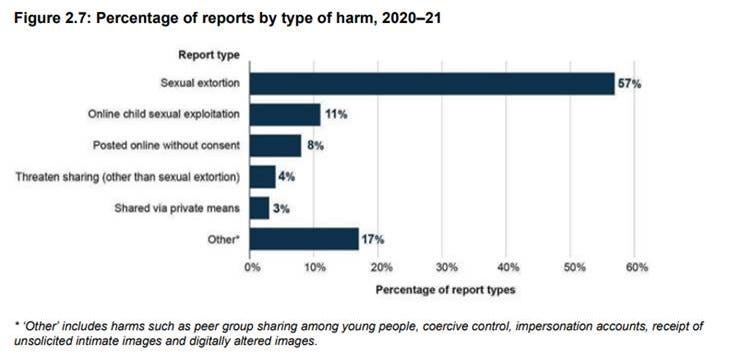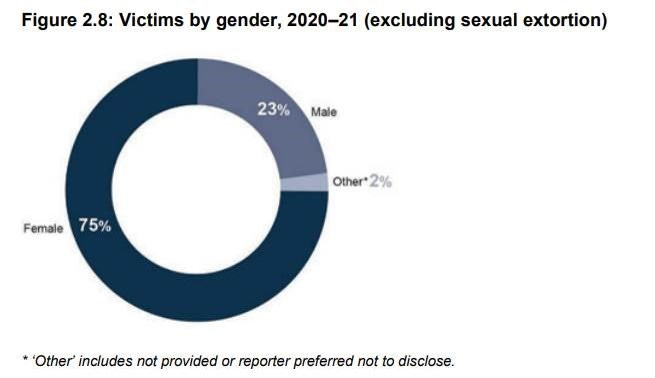
Judging from this, sexual extortion of males should be right up there in eSafety's core business.
That's just not going to happen. The next graph in that report claimed to represent the gender breakdown of victims of image-based abuse. Yet, in a revealing sleight of hand, they excluded sexual extortion. They left out the form of abuse which accounts for most (57%) of the total problem so they could proudly claim "victims of image-based abuse were predominantly female."
Advertisement

There is a section on the eSafety website which gives advice on dealing with sexual extortion, but this includes not one word suggesting boys are particularly vulnerable. The advice features one of the very rare male photos, midst a website festooned with images of women and girls, but the featured story concerns 40-year-old Michael who is blackmailed by a woman he met through online dating – nothing to do with the story being currently highlighted by the police.
Proud newcomer in the domestic violence politburo
Keeping all the emphasis on female victims is essential to eSafety's main game, which is all about establishing themselves as the high-tech arm of the domestic violence industry.
Julie Inman Grant's speech last September to the National Summit of Women's Safety was a big deal. She was the keynote speaker for this powerful gathering, which brings together key players to plot the new domestic violence national plan – following up their previous plan which attracted $3 billion in government funding over the previous decade.
Like the proud mother of new child, Inman Grant was there to celebrate her contribution to the powerful industry, which has already achieved such remarkable expansion in the list of behaviour enshrined into law as domestic violence, adding to initial territory focussed on purely physical abuse by claiming new types of villainy – psychological, emotional, financial, "threats" of abuse, and their latest coup, coercive control.
Advertisement
Inman Grant's baby is TFA or "technology-facilitated abuse." As she explained, "technology being used to isolate, harass, monitor, stalk, impersonate, threaten or humiliate someone else… It may take many forms including sharing or threatening to share intimate images and using tracking devices, voice recorders or cameras - which can be hidden in cars, children's toys, or even on the undersides of prams." Wow, how's that for a chilling threat, tracking a baby's pram?
According to Inman Grant, TFA is overwhelmingly gendered – "with the victims almost always women and abusers almost always men." She claimed online abuse of women is different from that targeting men – "It tends to be violent, sexualised, focused on appearance, and may question a women's supposed virtue or even their fertility."
Like the other forms of domestic violence which we are assured keep most women in a state of terror, here too we are told women everywhere are affected. Gendered TFA is universal, they claim, with almost 60% of all girls worldwide experiencing some form of online sexual harm. Inman Grant earnestly informs her eager audience that "4 in 5 Australian women have or are experiencing some form of technology-facilitated abuse."
Discuss in our Forums
See what other readers are saying about this article!
Click here to read & post comments.
8 posts so far.